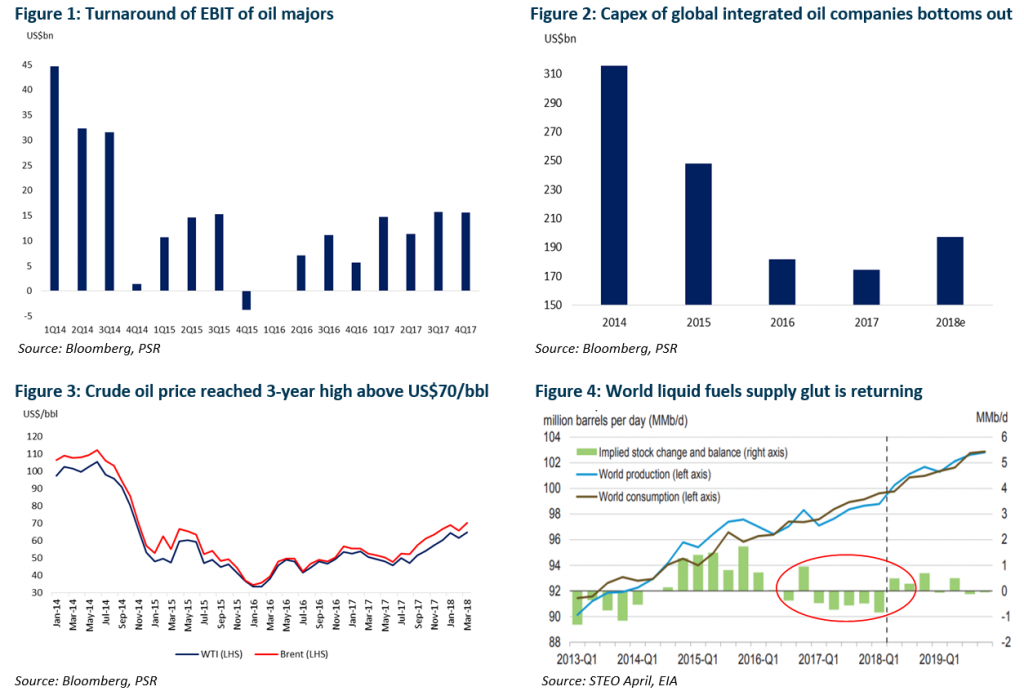Offshore & Marine Monthly: Extended Soft Conditions
traderhub8
Publish date: Mon, 16 Apr 2018, 05:27 PM
- Banks as de facto owners of vessels prolonging the supply imbalance
- Upstream production activities recover modestly but still depressed
- Offshore support vessels market is still in a predicament
- The rally of oil price will speed down as glut is coming back
Banks as de facto owners of vessels prolonging the supply imbalance
The prolonged downturn in oil market since 3Q14 has devastated the downstream vessel supply chain. Asset-heavy companies geared for a US$100 oil price have failed to meet their financial obligations, especially from banks. At present, banks are controlling assets such as vessels, rigs, and other facilities, taken over from loan defaulters. Faced with the difficulty of disposing of the assets, we believe banks are still keeping many vessels afloat. Such assets operate under minimal positive cash flows and managed by either third party operators hired by banks/creditors or the original owners. Assets that should have been scrapped remain operational and have prolonged the supply imbalance, in our opinion.
Upstream production activities have recovered modestly but still depressed
Offshore drilling and production activity has recovered modestly. Day rates have inched up, but utilisation rates remain under pressure, see Figure 5. The rig count increased moderately in 3Q17 and 4Q17 but came back down in 1Q18. Meanwhile, the corresponding utilisation rate hovers between 60% and 65% (20ppt from the peak period in 2014), shown in Figure 6. Moving forward, as profitability recovers for the upstream owners (Figure 1), we envisage capex on exploration and development to improve eventually, shown in Figure 2. However, such drilling activities may only resuscitate early 2019 onwards.
Offshore support vessels market is still in a predicament
Offshore support vessels (OSVs) remain oversupplied. The OSVs that have found work are predominantly under short-term contracts (1 or 2 years). OSVs owners have actually declined the offers of long-term contracts as they do not want to be locked into a low rate which barely covers the operating costs. In 1Q18, the number of OSVs sold for scrap have spiked up, signaling some deterioration in oversupply conditions, shown in Figure 7. Moving forward, the demand for OSVs will return as oil companies need drilling work to replenish their reserves and step up any delayed maintenance work. Until such an environment returns together with the further scrapping of vessels, any meaningful rebound in rates or utilisation will be elusive.
Expect the rally in oil price to dial down
Recently, oil prices (Brent) climbed back to a 3-year high of US$72/bbl, resulting from geopolitical tensions, dwindling supply, OPEC supply freeze and even Saudi Arabia hopes to bring oil price back to US$80/bbl. The rally in oil prices began in 3Q17, see Figure 3. This was in line with the reversal of the 3-year inventory glut (3Q14 to 3Q17). Since 1Q17 inventory has seen continuous drawdown, underpinning the recovery of prices, according to EIA’s Short-Term Energy Outlook in April, see Figure 4. However, we expect the fastest phase of the inventory decline is over, and any momentum in crude oil prices will taper off.
Source: Phillip Capital Research - 16 Apr 2018
More articles on Trader Hub
Created by traderhub8 | Jun 12, 2024
Created by traderhub8 | Jun 03, 2024



















